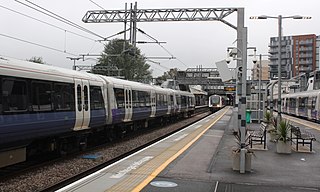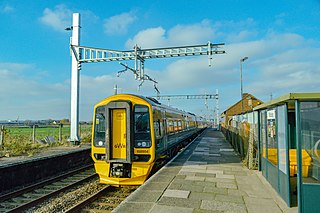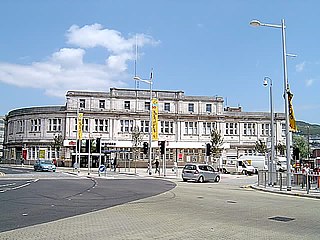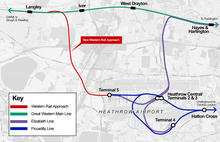
Bristol Temple Meads is the oldest and largest railway station in Bristol, England. It is located 118 miles 31 chains away from London Paddington. It is an important transport hub for public transport in the city; there are bus services to many parts of the city and surrounding districts, with a ferry to the city centre. Bristol's other major station, Bristol Parkway, is a more recent station on the northern outskirts of the conurbation.

Bristol Parkway, on the South Wales Main Line, is in the Stoke Gifford area in the northern suburbs of the Bristol conurbation. It is 112 miles (180 km) from London Paddington. The station was opened in 1972 by British Rail, and was the first in a new generation of park and ride/parkway stations. It is the third-most heavily used station in the West of England local authority area, after Bristol Temple Meads and Bath Spa. There are four platforms, and a well-equipped waiting area. The station is managed by Great Western Railway, who provide most of the trains at the station, with CrossCountry providing the rest.

Paddington, also known as London Paddington, is a Central London railway terminus and London Underground station complex, located on Praed Street in the Paddington area. The site has been the London terminus of services provided by the Great Western Railway and its successors since 1838. Much of the main line station dates from 1854 and was designed by Isambard Kingdom Brunel.

Cardiff Central railway station is a major station on the South Wales Main Line, located in the capital of Wales, Cardiff. It is one of the city's two urban rail network hubs, along with Cardiff Queen Street. Opened in 1850 as Cardiff station, it was renamed Cardiff General in 1924, and then Cardiff Central in 1973.

The Great Western Main Line (GWML) is a main line railway in England that runs westwards from London Paddington to Bristol Temple Meads. It connects to other main lines such as those from Reading to Penzance and Swindon to Swansea. Opened in 1841, it was the original route of the first Great Western Railway which was merged into the Western Region of British Railways in 1948. It is now a part of the national rail system managed by Network Rail with the majority of passenger services provided by the current Great Western Railway franchise.

Reading railway station is a major transport hub in Reading, Berkshire, England. It is on the northern edge of the town centre, near the main retail and commercial areas and the River Thames, 36 miles (58 km) from London Paddington.

Hayes & Harlington is a railway station serving the west London districts Hayes and Harlington in the London Borough of Hillingdon. It is 10 miles 71 chains down the line from London Paddington and is situated between Southall and West Drayton.

Didcot Parkway is a railway station serving the town of Didcot in Oxfordshire, England. The station was opened as Didcot on 12 June 1844 and renamed Didcot Parkway on 29 July 1985 by British Rail to reflect its role as a park and ride railhead. It is 53 miles 10 chains down the line from London Paddington and is situated between Cholsey to the east and Swindon to the west.

Newport railway station is the second-busiest railway station in Wales, situated in Newport city centre. It is 133.5 miles (215 km) from London Paddington on the British railway network.

Pilning railway station is a minor station on the South Wales Main Line near Pilning, South Gloucestershire, England. It is 10 miles (16 km) from Bristol Temple Meads and is the last station on the English side before the Severn Tunnel through to Wales. Its three letter station code is PIL. It is managed by Great Western Railway, who provide the two train services per week from the station.

Swansea railway station serves the city of Swansea, Wales. It is 186 miles 7 chains (299 km) measured from London Paddington on the National Rail network.

The South Wales Main Line, originally known as the London, Bristol and South Wales Direct Railway or simply as the Bristol and South Wales Direct Railway, is a branch of the Great Western Main Line in Great Britain. It diverges from the core London-Bristol line at Royal Wootton Bassett beyond Swindon, first calling at Bristol Parkway, after which the line continues through the Severn Tunnel into South Wales.

Filton Abbey Wood railway station serves the town of Filton in South Gloucestershire, England. It is 4.4 miles (7.1 km) from Bristol Temple Meads. There are four platforms but minimal facilities. The station is managed by Great Western Railway that operates all services. The general service level is eight trains per hour - two to South Wales, two to Bristol Parkway, two toward Weston-super-Mare and two toward Westbury.

Swindon railway station is on the Great Western Main Line in South West England, serving the town of Swindon, Wiltshire. It is 77 miles 23 chains down the line from the zero point at London Paddington and is situated between Didcot Parkway and Chippenham on the main line. It is managed by Great Western Railway, which also operates all the trains.

Patchway railway station is on the South Wales Main Line, serving the town of Patchway and village of Stoke Gifford in South Gloucestershire, England. It is 6 miles (10 km) from Bristol Temple Meads. Its three letter station code is PWY. It is managed by Great Western Railway, who provide all train services at the station, mainly a train every hour in each direction between Cardiff Central and Taunton.

Milford Haven railway station serves the town of Milford Haven in Pembrokeshire, Wales. Opened on 7 September 1863, it was originally known as Milford, becoming Old Milford by January 1902, and finally being renamed Milford Haven by April 1910. It is the westernmost railway station in Wales, but not in Great Britain as some stations in England and Scotland are further west.

Lawrence Hill railway station is on the Severn Beach Line and Cross Country Route, serving the inner-city districts of Easton and Lawrence Hill in Bristol, England. It is 1.0 mile (1.6 km) from Bristol Temple Meads. Its three letter station code is LWH. The station has two platforms, four running lines and minimal facilities. It is managed by Great Western Railway, the seventh company to be responsible for the station and the third franchise since privatisation in 1997. They provide all train services at the station, the standard service being two trains per hour along the Severn Beach Line and an hourly service between Bristol Temple Meads and Filton Abbey Wood.

Bedminster railway station is on the Bristol to Exeter line and serves the districts of Bedminster and Windmill Hill in Bristol, south-west England. It is 0.9 miles (1.4 km) to the west of Bristol Temple Meads, and 119 miles (192 km) from London Paddington. Its three letter station code is BMT. It was opened in 1871 by the Bristol and Exeter Railway, was resited slightly further to the west in 1884 and was rebuilt in 1932. The station, which has three through-lines and two island platforms, but minimal facilities, is managed by Great Western Railway who operates all train services that serve the station, mainly an hourly service between Bristol Parkway and Weston-super-Mare.

Ashley Hill railway station was a railway station serving the area of Ashley Down in the north of Bristol, England. It was located on what is now known as Filton Bank. It was served by stopping trains to Severn Beach, Avonmouth and Swindon . The West of England Combined Authority plan to open a new train station, to be called Ashley Down, on the site of Ashley Hill station, in 2023.
Rail transport in Cardiff has developed to provide connections to many other major cities in the United Kingdom, and to provide an urban rail network for the city and its commuter towns in southeast Wales. Today, there are three train operating companies in Cardiff: Great Western Railway, CrossCountry and Transport for Wales.






























